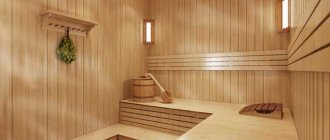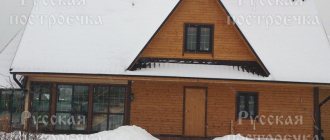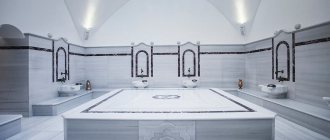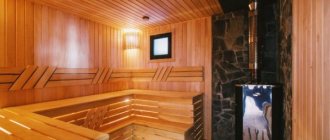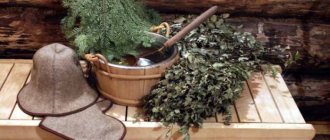“If there are brooms, an ice hole and tea, it’s a bathhouse, but when there’s vodka, barbecue and girls, it’s already a sauna.”
Greetings to all blog visitors!
There are many types of baths on earth. They are also found in Japan - Ofuro, Indonesia, Brazil and Mexico. Each relies on its own rituals and traditions. However, ours is both closer and dearer to us. But... still one of the “foreign” bathhouse cultures managed to put down strong roots on Russian soil.
This is a Finnish sauna. And sometimes disputes arise: what is better, more useful, more correct. To me, this is like an argument about women. Blondes or brunettes, how to choose? Therefore, today we’ll talk about the difference between a sauna and a bathhouse. Neutral comparison, without emotions, essentially...
The ancestor of both baths is a log hut.
By the way, the Finnish people are indigenous people from Western Siberia. More precisely, from the territories of the current Khanty-Mansiysk Okrug. They are not Scandinavians. From ours it became...
The main differences: humidity and air temperature
The most fundamental difference is the humidity of the steam: in the bath it is low temperature and humid, but in the sauna it is very hot and dry. The large amount of moisture-saturated steam in the air of a Russian bath is determined by some other features of these two rooms considered here. These include the design of the stoves and the method of heating the steam room.
It is worth noting that the low temperature of the bath (about 60°C) together with high humidity allows you to get several advantages at once:
- the absence of scalding hot air, which irritates and dries out the mucous membranes;
- the body in the bathhouse warms up much better, which promotes increased release of toxins and excellent normalization of the functioning of some internal organs;
- maximum humidity prevents droplets of water and sweat from evaporating from the surface of the skin, which protects the steamer from dehydration, which is dangerous for the body;
- The bathhouse is recommended for visiting by people with certain cardiovascular diseases and those who suffer from diseases of the upper respiratory tract (people of these categories are absolutely not allowed to go to the sauna).
Hot steam Source metropoles.com
For comparison: air humidity in a bathhouse is about 70% (from 50% to 90%), in a sauna it is about 20%; the temperature in the bathhouse is 60°C (on the top shelf it may be higher), in the sauna – 100°C and above. Thanks to such indicators, more natural and healthy conditions are observed in the bathhouse.
See also: Catalog of companies that specialize in the design, construction and arrangement of baths and saunas
Conclusion
If you decide to make a steam room on your property, you need to decide on its type, because depending on the type chosen, you will have to equip the room completely differently. It is worth noting that a steam room in a sauna is much simpler to implement; there are many small stoves on sale, which come with instructions for use that guarantee a good result (find out here what materials can be used to build baths and saunas).
But in a Russian sauna it is much more difficult to achieve good steam, so it is worth deciding which solution will be best for you. We hope the video in this article will answer all questions, if any remain.
Did you like the article? Subscribe to our Yandex.Zen channel
Stones, steam and oven
When considering the problem “Sauna and bathhouse: what is the difference,” it is worth paying attention to the methods of heating and generating steam in these two rooms. Thus, a sauna requires the presence of an electric stove with stones placed on it, and in a bathhouse, in most cases, stones are placed inside and no electric heating elements are used, only natural aromatic firewood.
The stones in the steam room can be either open or closed. In the first case, it is very convenient to add water to them to add steam to the room. In the second case, that is, when the stones are closed behind closed oven doors, another advantage appears: the temperature of the hot stones is maintained for a longer period of time.
Stones in the bath Source yandex.net
Historical facts about the Russian bath
Since ancient times, the bathhouse has been considered a remedy for many ailments, as well as a way to have a good rest with health benefits. Our ancestors endowed the bathhouse with magical properties - they performed fortune telling in it and delivered babies.
As you know, the first baths were heated black, without a stove or chimney. Over time, traditional saunas with a heater, in which smoke does not spread throughout the room, came to replace it. This type is still used today.
Many people see the difference between a Russian bath and a sauna only in the name; in fact, this is far from the case, because the sauna is fundamentally different both in the properties of the steam and in its history.
In a black sauna, smoke comes out through the door or window
Design differences
In the vast majority of cases, a Russian bathhouse is a free-standing wooden building (it is best to build it from coniferous wood), which has two rooms: a steam room or steam room itself and a dressing room, which serves as a locker room, a relaxation room and a hallway. The main part of the furnace is also located in this auxiliary room.
Steam room in the bath Source stroy-podskazka.ru
A sauna necessarily contains a swimming pool in its design, the function of which in the case of a bathhouse is replaced by a natural (or, in extreme cases, artificial) reservoir located in close proximity to the log house. Also in the sauna, in addition to the sweat room (analogous to a steam room), the changing room (analogous to a dressing room), there is a soap compartment.
Some visiting traditions
Russian bath
A broom is the main attribute. Different brooms have different effects. On the one hand, massage, on the other, the aroma released from steamed leaves under the influence of temperature.
You can move in the steam room. After leaving the steam room, you need to sit in the dressing room. Relax. About the pool??? Previously, baths were built near reservoirs, but now swimming pools are built in.
When is a building permit necessary?
In accordance with the Town Planning Code of the Russian Federation, approval is required for permanent buildings - residential and engineering structures. The law provides a list of buildings that do not require a permit - garages and other buildings not related to making a profit. Whether baths can be classified as one of them cannot be answered unequivocally. Small premises without communications are included in this list, but often such structures are built on a large scale and comfort.
If the owner decides to add a sauna or bathhouse to the cottage, permits are required. In this situation, changes occur in the authorized housing plan, so adjustments must be agreed upon by various authorities. The assessment is given not only to the increase in area, but also to the characteristic parameters of strength, sanitary, and fire safety.
The installation of water, sewer or gas systems also requires coordination with the right institutions. In case of unauthorized removal of communication systems, significant penalties are imposed.
Distinctive features of the Finnish sauna:
- dry air has lower heat capacity and thermal conductivity, and therefore temperatures of 100–120 °C are especially easily tolerated due to the relatively low humidity;
- humidity level - 5–10%;
- the average temperature in the steam room is about 100 °C;
- It is very important to add water to the stones correctly so that it does not lead to burns. The Finns do this slowly and in small portions, while the humidity increases for a short period of time;
- dry air gradually warms up the body, profuse sweating occurs, which is considered a kind of protection of the body from overheating.
Thanks to the active process of sweating, thermoregulatory functions are activated in the sauna, as a result of which waste and toxins are effectively removed from the body.
Stones are another difference between Russian and Finnish steam rooms. So, in a Russian bathhouse, the stones are located inside the stove behind a closed door, which is opened to add water. As a result, the stones heat up three to four times more than when they are lying on an open base.
In a Finnish sauna, the stones lie on the open surface, but they can be watered with water to also receive healing steam. True, such clubs quickly evaporate. Modern saunas use electric heaters with stones to heat the air. A distinctive feature of such a “firebox” is the ability to regulate the intensity of the furnace operation and select the optimal temperature level.
Correct location of the bathhouse on the site - distances from borders and other objects
The correct location of the bathhouse at a distance from the boundaries of the site is one of the main requirements for its construction, since it ensures fire and sanitary safety. If the development plan is carried out by a design bureau, you don’t have to worry about meeting all the requirements. But if you decide to plan the location of the house and bathhouse on the site yourself, we recommend that you familiarize yourself with the information that we will present later in the article.
Before the fence
The indicator may increase taking into account the height of the fence and the material from which it is built. Such restrictions will protect against fire and sewage entering the site.
When the neighboring area is not built up, the distance can be reduced to 2.5 m. But provided that the height of the bathhouse along the ridge line does not exceed 3 m.
To the neighbor's fence
The recommended setback from the border of the neighboring plot is 3 m.
As in the previous case, the distance can be increased for reasons of fire and environmental safety. Plus, a building with an attic is a significant shading of the neighboring estate.
When planning a corner structure, the requirements of the regulations often have to be violated, so it is better to discuss this point with the neighbors in advance and obtain their written permission.
To the neighbor's house
In accordance with urban planning requirements, a distance of 8 m must be taken from the bathhouse to the neighboring or own house. When the structure is built from non-combustible materials, the distance is reduced to 6 m.
If the side of the house that the sauna faces is solid (without windows) made of brick, blocks or stone, then the required distance is reduced to 1 m.
Provided that the bathhouse will be built later than the neighbor's house, the party who plans the construction must comply with the requirements of the code.
To the bathhouse (in neighboring areas)
The acceptable distance between two bathhouses is considered to be 2 m. One of the bathhouses can be located a meter from the fence if it has a central sewerage system with drainage.
According to fire safety requirements for buildings made of flammable materials, the distance increases to 5 m.
This is often practiced in rural areas. When there is a garden, sheds, vegetable garden, and pens for livestock around the sauna. And the house and other residential properties are located in the opposite part of the site.
To other buildings on the estate
The sauna is allowed to be placed 1 m from other buildings of economic importance, provided that both structures are made of fire-resistant materials.
The benefits of the Turkish steam room
Hammam and sauna differ in the amount of wet vapor. While Finnish steam rooms are filled with dry air, Turkish baths maintain a humid microclimate. Due to the bath conditions, sweating is minimal, and the body gets wet due to the formation of condensation. The skin and hair do not dry out, so the hammam is a good alternative to the steam room for people suffering from allergies and increased sensitivity of the body. Despite the slight heating of the room, under the influence of moisture the pores expand faster.
It is advisable to arrange steam sessions in Turkish steam rooms:
- For people who prefer to accompany steam treatments with aromatherapy. The hammam provides the opportunity to visit the solarium.
- In order to strengthen the functioning of the heart and blood vessels.
- For complete warming up of muscles and joints.
- In order to relieve stress, conduct relaxation sessions.
- To combat the symptoms of bronchitis and runny nose at an early stage.
- For girls who want to thoroughly cleanse their skin pores of dirt.
- In order to normalize metabolism and rejuvenate the body. Weight loss occurs faster if you combine training and a balanced diet with a visit to the hammam.
Essential oils for aromatherapy
Registration process
Is it possible to register an unauthorized sauna building? It is not difficult to obtain permission for a building constructed on the land of individual housing construction, private household plots or dacha territory, although unauthorized construction is considered a civil offense. You can register without imposing sanctions if the premises comply with existing rules. Previously, the presence of a bathhouse was not welcomed and was not subject to legalization. Today such a right exists; after registration, the building becomes private property with the possibility of inheritance.
The resolution of the problem has been simplified by the adoption of by-laws; the dacha amnesty has been extended for the current year, which makes it possible to register property by filing a declaration in a simplified manner.
You will need to collect the necessary documents:
- land ownership certificate;
- cadastral passport of the house and land;
- receipt for payment of state duty;
- technical passport of the real estate;
- passport.
Houses and buildings that are subject to registration are registered in a short time. The dacha amnesty is used by citizens who have illegal buildings on their property.
You can register a previously built bathhouse by submitting information to the cadastral service:
- an application with the name of the location of the plot and building;
- function of an auxiliary building;
- building plan (indicating category, area, number of floors);
- the structure of the sauna with the name of the materials used, the type of stove device, the location of the internal rooms;
- communications (sewage, ventilation system); show how the water supply is installed (well, borehole), how the runoff is drained and drainage is carried out.
Whether or not to decorate a bathhouse is determined by the individual desire of the owner. The exception is significant structures, which are considered capital buildings. Registration will help solve many problems:
- Sale of land ownership. The official building is private property with a certain value, this will avoid conflict situations.
- Inheritance. When dividing the territory, the bathhouse will be an independent object.
- Insurance, donation.
- No claims from regulatory authorities. Registration makes the bathhouse a legal building, allows you to use communications without problems and rent out the building.
In the absence of a technical passport, cadastral engineers should be invited who will take the necessary measurements to link the object to the land plot. The services will cost approximately 10,000 rubles, the final cost is determined by the area of the facility.




